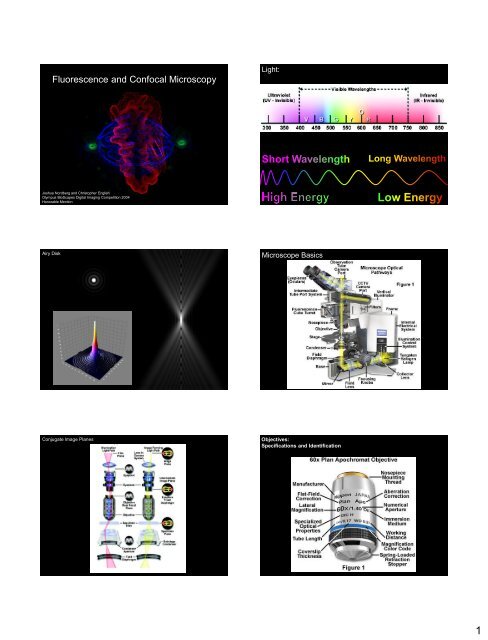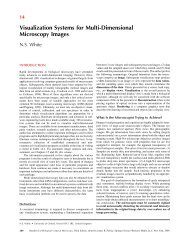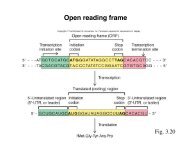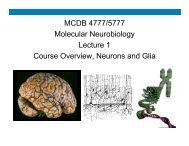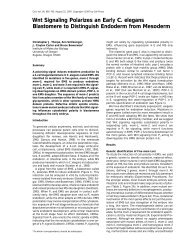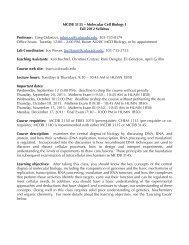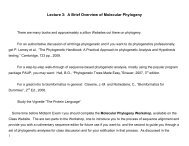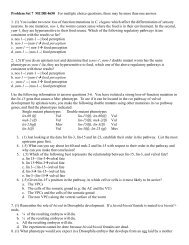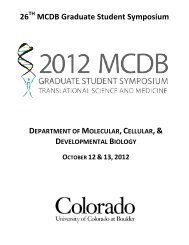Fluorescence and Confocal Microscopy
Fluorescence and Confocal Microscopy
Fluorescence and Confocal Microscopy
Create successful ePaper yourself
Turn your PDF publications into a flip-book with our unique Google optimized e-Paper software.
<strong>Fluorescence</strong> <strong>and</strong> <strong>Confocal</strong> <strong>Microscopy</strong><br />
Joshua Nordberg <strong>and</strong> Christopher English<br />
Olympus BioScapes Digital Imaging Competition 2004<br />
Honorable Mention<br />
Light:<br />
Airy Disk Microscope Basics<br />
Conjugate Image Planes Objectives:<br />
Specifications <strong>and</strong> Identification<br />
1
Objectives:<br />
Chromatic Aberration<br />
Objectives:<br />
Air vs. Oil<br />
<strong>Fluorescence</strong><br />
Objectives:<br />
Numerical Apertures<br />
Mag<br />
Plan Achromat<br />
(NA)<br />
Plan Fluorite<br />
(NA)<br />
Plan Apochromat<br />
(NA)<br />
0.5x 0.025 n/a n/a<br />
1x 0.04 n/a n/a<br />
2x 0.06 n/a 0.10<br />
4x 0.10 0.13 0.20<br />
10x 0.25 0.30 0.45<br />
20x 0.40 0.50 0.75<br />
40x 0.65 0.75 0.95<br />
40x (oil) n/a 1.30 1.00<br />
60x 0.75 0.85 0.95<br />
60x (oil) n/a n/a 1.40<br />
100x (oil) 1.25 1.30 1.40<br />
Objectives:<br />
Light-Gathering Power<br />
Correction Magnification<br />
Numerical<br />
Aperture<br />
F(trans) F(epi)<br />
Plan Achromat 10x 0.25 6.25 0.39<br />
Plan Fluorite 10x 0.30 9.00 0.81<br />
Plan Apo 10x 0.45 20.2 4.10<br />
Plan Achromat 20x 0.40 4.00 0.64<br />
Plan Fluorite 20x 0.50 6.25 1.56<br />
Plan Apo 20x 0.75 14.0 7.90<br />
Plan Achromat 40x 0.65 2.64 1.11<br />
Plan Fluorite 40x 0.75 3.52 1.98<br />
Plan Apo 40x (oil) 1.30 11.0 18.0<br />
Plan Fluorite 60x 0.85 2.01 1.45<br />
Plan Apo 60x (oil) 1.40 5.4 10.6<br />
Plan Apo 100x (oil) 1.40 1.96 3.84<br />
Plan Apo 100x (oil) 1.45 2.10 4.42<br />
Plan Apo 100x (oil) 1.65 2.72 7.41<br />
Hit by High<br />
Energy Photon<br />
e -<br />
e -<br />
Ground State<br />
Excited States<br />
Emit Low<br />
Energy Photon<br />
2
• Physical Process<br />
– Excitation: S 0 + hv → S 1<br />
<strong>Fluorescence</strong><br />
– <strong>Fluorescence</strong> (emission): S 1 → S 0 + hv<br />
• S 0 is the ground state of the fluorophore<br />
• S 1 is the first excited state of the fluorophore<br />
• hν is a generic term for photon energy where:<br />
– h = Planck’s Constant<br />
– ν = Frequency of light<br />
Fluorophores<br />
Giepmans et al., 2006<br />
Green Fluorescent Protein<br />
• GFP was first cloned in 1992 from Aequorea<br />
victoria by Douglas Prasher.<br />
• Prahser also successfully expressed GFP in C.<br />
elegans in 1994.<br />
<strong>Fluorescence</strong><br />
<strong>Fluorescence</strong> Quantum Yield<br />
– the efficiency of the fluorescence process<br />
– Φ = # photons emitted<br />
# photons absorbed<br />
– The theoretical maximum fluorescence quantum<br />
yield is 1.0 (100%) where every photon absorbed<br />
results in a photon emitted.<br />
RCSB Protein Data Bank<br />
Aequorea victoria<br />
3
<strong>Fluorescence</strong> Imaging<br />
Transmitted (or Diascopic) illumination<br />
Nikon (www.microscopyu.com)<br />
Illumination Techniques<br />
• Transmitted (or Diascopic) illumination<br />
• Reflected (or Episcopic) illumination<br />
Reflected (or Episcopic) Illumination<br />
Nikon (www.microscopyu.com)<br />
Nikon (www.microscopyu.com)<br />
4
Nikon (www.microscopyu.com) Nikon (www.microscopyu.com)<br />
Widefield :<br />
Nikon (www.microscopyu.com)<br />
Widefield :<br />
Point Scanning:<br />
Point Scanning:<br />
Nikon (www.microscopyu.com)<br />
<strong>Confocal</strong> Imaging:<br />
• The invention of the confocal microscope is attributed<br />
to Marvin Minsky, who produced a working<br />
microscope in 1955.<br />
• It was developed to eliminate out-of-focus haze of<br />
fluorescent samples.<br />
5
Light<br />
Source<br />
First<br />
Pinhole<br />
Condenser Sample Objective<br />
Illumination of<br />
a Single Point<br />
Collection from<br />
the Same Point<br />
http://web.media.mit.edu/~minsky/papers/<strong>Confocal</strong>Memoir.html<br />
Second<br />
Pinhole<br />
<strong>Confocal</strong> Imaging<br />
(its all about the pinhole)<br />
Detector<br />
• Any light that passed the second pinhole struck<br />
a photomultiplier, which generated a signal that<br />
was related to the brightness of the light from the<br />
specimen.<br />
• The second pinhole prevented light originating<br />
from above or below the plane of focus in the<br />
specimen from reaching the photomultiplier.<br />
Spinning Disk <strong>Confocal</strong><br />
<strong>Confocal</strong> Imaging<br />
(its all about the pinhole)<br />
• Minsky's original configuration used a pinhole placed<br />
in front of a zirconium arc source as the point source<br />
of light.<br />
• The point of light was focused by an objective lens at<br />
the desired focal plane in the specimen, <strong>and</strong> light that<br />
passed through it was focused by a second objective<br />
lens at a second pinhole having the same focus as the<br />
first pinhole (the two were confocal).<br />
<strong>Confocal</strong> Systems:<br />
• Spinning Disk <strong>Confocal</strong> Scope<br />
• LASER Scanning <strong>Confocal</strong> Microscope<br />
– Single Photon<br />
• Fluorophores are excited by one photon of high(er)<br />
energy light<br />
– Two Photon<br />
• Fluorophores are excited by two photon of low(er)<br />
energy light<br />
Laser Scanning <strong>Confocal</strong><br />
Nikon (www.microscopyu.com)<br />
6
Controlling Image Quality:<br />
• Spinning Disk <strong>Confocal</strong> Microscope<br />
– Exposure (ms)<br />
– Gain (software)<br />
– Digitizer<br />
– EM-Gain (hardware)<br />
– Frame Averaging<br />
• LASER Scanning <strong>Confocal</strong> Microscope<br />
– Frame Size (X Pixels by Y Pixels)<br />
• Pixel Size<br />
– Scan Speed<br />
– Pinhole Size<br />
– Gain<br />
– Frame Averaging<br />
What are Digital Images<br />
• Digital images are stored using binary code (1 or 0)<br />
• Bit depth: potential grayscale pixel<br />
Monochromatic Bit Depth<br />
• 1 bit = 2 gray levels<br />
• 2 bit = 4 gray levels<br />
• 4 bit = 16 gray levels<br />
• 8 bit = 256 gray levels<br />
• 12 bit = 4,096 gray levels<br />
• 16 bit = 65,536 gray levels<br />
Color Images<br />
• 24-bit RGB images<br />
– 8-bits for each of the red, green <strong>and</strong> blue channels<br />
Noise<br />
1. Statistical Noise: R<strong>and</strong>om fluctuations in signal<br />
2. Dark (Thermal) Noise<br />
•Electrons pop out of the chip as it heats up<br />
•They build up with long exposure time<br />
•Can be reduced by cooling chip<br />
3. Read Out Noise<br />
•Errors as chip is read<br />
•Constant, regardless of exposure time<br />
•Can be reduced by reading the chip more slowly<br />
4. Camera Noise (Dark + Readout)<br />
5. Total Noise (Signal noise + Camera noise)<br />
1.25 MHz/pixel<br />
10 MHz/pixel<br />
Images collected by JWS in the Nikon Imaging Center at Harvard Medical School<br />
Digital Images:<br />
Separating Signal from Noise<br />
Ted Hinchcliffe & Kenneth Spring<br />
• Signal is defined as the change in the state of a detector produced by<br />
photons from the object of interest.<br />
• Noise is defined as meaningless fluctuations in the signal. It is of three<br />
kinds:<br />
• Optical Noise is defined as any detected photon produced by stray light<br />
from the microscope or scattered from the object of interest.<br />
• Camera Noise is defined as any change in the detector output not<br />
produced by photons from the object of interest.<br />
• Statistical Noise is defined as fluctuations in signal that arise from the<br />
r<strong>and</strong>om changes that result from inadequate sampling.<br />
Signal-to-noise ratio <strong>and</strong> its effect on image quality.<br />
7
Ways to increase the signal that the camera sees<br />
•Brighter sample<br />
•Align illumination optics (Koehler illumination) & bulb<br />
•Brighter objective lens (B = NA 4 / M 2 )<br />
•Higher transmission objective lens (less aberration correction)<br />
•Decrease specimen noise (mounting medium, BG fluorescence)<br />
•Decrease other optical noise (minimize reflective surfaces, use<br />
field diaphragm, work in dark, no dirt)<br />
Detectors: Photomultiplier Tube (PMT)<br />
Strengths: very low noise <strong>and</strong> allow rapid data collection<br />
Weaknesses: old designs don’t count every photon (GaAs PMTs, 10%<br />
efficient), but new PMTs GaAsP) are about 40% efficient at their spectral<br />
optimum.<br />
Nikon (www.microscopyu.com)<br />
A metaphore<br />
for CCD camera<br />
readout<br />
Gain:<br />
• The amount that an analog signal has been amplified. For video, gain is used to<br />
increase or decrease the dynamic range of a video camera by selecting the voltage<br />
levels that the digitizer will accept.<br />
• For example, when viewing a faint image, the gain is often raised to increase the<br />
minute changes into those that are more readily detectable.<br />
Increasing gain reduces the number of gray levels<br />
Increasing gain, Same exposure time<br />
Offset (Black Level), can be used to re-zero the gray scale<br />
Detectors: Charged Coupled Device (CCD)<br />
Images collected by JWS in the Nikon Imaging Center at Harvard Medical School<br />
The sensitivities of various electronic cameras: Video - CCD<br />
Photodiodes<br />
• A light-sensitive semi-conductor set up so<br />
incident light can knock electrons loose.<br />
• A “loose” electron leaves behind a zone of<br />
positive charge or a “hole”<br />
• Electrons <strong>and</strong> holes can move in response to<br />
an electric field<br />
• Current is then proportional to the number of<br />
“loose” electrons, i.e., to number of incident<br />
photons<br />
8
Diagram of an individual CCD “Well” or “Pixel”<br />
full well capacity<br />
on the order of ~1000 electrons/µm 2<br />
Spectral Sensitivity & QE<br />
Detector: Electron Multiplier CCD(EM-CCD)<br />
Hazelwood et al., from Shorte <strong>and</strong> Frischknecht 2007<br />
Graph from microscopyu.com<br />
Hamamatsu<br />
Improvements in Interline CCDs<br />
Single microlens added<br />
No microlens<br />
Detector: Charged Coupled Device (CCD)<br />
ORCA- ER<br />
500ms, High Gain<br />
Input<br />
light<br />
EM-CCD Performance<br />
EM-CCD<br />
200ms, Low Multiplication<br />
Open window<br />
EM-CCD<br />
200ms, Med Multiplication<br />
Microlens<br />
Image from Butch Moomaw, Hamamatsu<br />
Hamamatsu<br />
EM-CCD<br />
50ms, High Multiplication<br />
Images collected by JWS in the Nikon Imaging Center at Harvard Medical School<br />
9
Detector: Electron Multiplier CCD(EM-CCD)<br />
Dangers of Converting<br />
From 16 Bit to 8 Bit<br />
Hamamatsu<br />
Detector: Electron Multiplier CCD(EM-CCD)<br />
Nakano, 2002<br />
16 Bit 16 Bit<br />
16 Bit 16 Bit 8 Bit 8 Bit<br />
Hamamatsu<br />
10
Starting Images<br />
Ending Images<br />
16 Bit 16 Bit<br />
8 Bit 8 Bit<br />
References<br />
• Douglas C. Prasher, Virginia K. Eckenrode, William W. Ward, Frank G. Prendergast <strong>and</strong> Milton J.<br />
Cormier. Primary structure of the Aequorea victoria green-fluorescent protein. Gene. 1992 Feb<br />
15;111(2):229-33.<br />
• Chalfie M, Tu Y, Euskirchen G, Ward W, <strong>and</strong> Prasher DC. Green fluorescent protein as a<br />
marker for gene expression. Science. 1994 Feb 11;263(5148):802-5.<br />
• Giepmans BN, Adams SR, Ellisman MH, <strong>and</strong> Tsien RY. The fluorescent toolbox for assessing<br />
protein location <strong>and</strong> function. Science. 2006 Apr 14;312(5771):217-24.<br />
• Shaner NC, Campbell RE, Steinbach PA, Giepmans BN, Palmer AE, <strong>and</strong> Tsien RY. Improved<br />
monomeric red, orange <strong>and</strong> yellow fluorescent proteins derived from Discosoma sp. red<br />
fluorescent protein. Nat Biotechnol. 2004 Dec;22(12):1567-72. Epub 2004 Nov 21.<br />
• Semwogerere D. <strong>and</strong> Weeks ER. <strong>Confocal</strong> <strong>Microscopy</strong> Encyclopedia of Biomaterials <strong>and</strong><br />
Biomedical Engineering 2005 Nov. 28 10;(1-10).<br />
• Nakano A. Spinning-disk confocal microscopy - a cutting-edge tool for imaging of membrane<br />
traffic. Cell Struct Funct. 2002 Oct;27(5):349-55.<br />
• Nikon <strong>Microscopy</strong> U<br />
– http://www.microscopyu.com/index.html<br />
11


